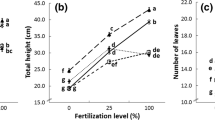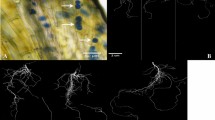Abstract
The influence of V.A. mycorrhization on mineral nutrition of 2 clones ofArgania spinosa was studied with in-vitro micropropagated plantlets grown in confined medium under controlled conditions. Inoculation, which increased dry matter production by a factor of 4.5, also increased P concentration in the plant, especially in the leaves, and the mycorrhizal plants mobilized 15 times more P than control plants. N concentration was slightly lower in mycorrhizal plants, but total N content was 3 times higher. Uptake of micro elements was also affected, inoculation increasing plant Fe, Zn and Cu content. Mineral nutrition in the test clones seemed affected by root/shoot ratio and other genetically-related characteristics, such as Fe translocation efficiency.
These results help us to understand how its deep mycorrhizal root system might allowArgania spinosa not only to grow in infertile arid areas but also to improve top-soil fertility by a litter effect.
Résumé
L'influence de la mycorhization V.A. sur la nutrition minérale de 2 clones d'Arganier (Argania spinosa) a été étudiée sur des plantules micropropagées in vitro poussant en conditions contrôlées. L'inoculation (qui augmentait la production de matière sèche d'un facteur 4,5) accroit également la teneur des plantes en phosphore, notamment dans les feuilles, et les plantes mycorhizées mobilisent 15 fois plus de phosphore que les plantes non inoculées. La teneur en azote est légèrement plus faible chez les plantes mycorhizées mais au total ces dernières exportent 3 fois plus d'azote. L'absorption des micro-éléments est aussi affectée par l'inoculation, qui accroit les teneurs des plantes en Fe, Zn et Cu. La nutrition minérale des deux clones étudiés semble affectée par le rapport racines/parties aériennes et d'autres caractéristiques génétiques, comme l'efficacité de translocation du fer. Ces résultats nous permettent de comprendre en quoi son système racinaire profond et mycorhizé permet à l'Arganier non seulement de pousser dans des zones arides aux sols pauvres, mais aussi d'améliorer la fertilité des couches supérieures du sol par l'effet litière.
Similar content being viewed by others
References
Abbott LK and Robson AD (1982) The role of vesicular-arbuscular mycorrhizal fungi in agriculture and the selection of fungi for inoculation. Australian Journal of Agricultural Research 33: 389–408
Amouroux JM (1978) Influence actuelle de la végétation sur trois substrats de la forêt d'Ademine (vallée du Souss, Maroc). Thèse doctorat de spécialité, Univ Aix-Marseille III, 89 pp
Benton Jones J Jr (1991) Plant tissue analysis in micronutrients. In: Micronutrients in agriculture, 2nd ed, SSSA Book Series No 4, 477–521
Blal B, Morel C, Gianinazzi-Pearson V, Fardeau JC and Gianinazzi S (1990) Influence of vesicular-arbuscular mycorrhizae on phosphate fertilizer efficiency in two tropical acid soils planted with micropropagated oil palm (Elaeis guineensis Jacq.). Biology and Fertility of Soils 9: 43–48
Bolan, NS, Robson AD and Barrow NJ (1987) Effects of vesicular-arbuscular mycorrhizae on the availability of iron phosphates to plants. Plant and Soil 99: 401–410
Boonne C, Wacquant JP and Jonard R (1992) In-vitro cloning ofDittrichia viscosa for screening nutritional ecotypes. Plant and Soil 142: 323–328
Gianinazzi-Pearson V, Fardeau JC, Asimi S and Gianinazzi S (1981) Sources of additional phosphorus absorbed from soil by vesicular-arbuscular mycorrhizal soybean. Physiologie Végétale 19: 33–43
Gianinazzi-Pearson V (1982) Importance des mycorhizes dans la nutrition et la physiologie des plantes In: Gianinazzi-Pearson V and Gianinazzi S (eds) Les mycorhizes: biologie et utilisations, pp. 51–59, INRA, Paris, France
Granger RL, Plenchette C and Fortin JA (1983) Effect of a vesicular-arbuscular (VA) endomycorrhizal fungus (Glomus epigaeum) on the growth and leaf mineral content of two apple clones propagated in vitro. Canadian Journal of Plant Science 63: 551–555
Greenwood DJ, Lemaire G, Gosse G, Cruz P, Draycott A and Neeteson JJ (1990) Decline in percentage N of C3 an C4 crops with increasing plant mass. Annals of Botany 66: 425–436
Habte M and Manjunath A (1987) Soil solution phosphorus status and mycorrhizal dependency inLeucaena leucocephala. Applied and Environmental Microbiology 53: 797–801
Jayachandran K, Schwab AP and Hetrick BAD (1992) Mineralization of organic phosphorus by vesicular-arbuscular mycorrhizal fungi. Soil Biology and Biochemistry 24: 897–903
Lambert DH, Baker DE and Cole H (1979) The role of mycorrhizae in the interaction of phosphorus with zinc, copper and other elements. Soil Science Society of America Journal 43: 976–980
Menge JA, Johnson EL and Platt RG (1978) Mycorrhizal dependency of several citrus cultivars under three nutrients regimes. New Phytologist 81: 553–559
Msanda F (1993) Écologie et cartographie des groupements végétaux d'Anzi (Anti-Atlas occidental, Maroc) et contribution à l'étude de la diversité génétique de l'arganier. Thèse université Grenoble, 116 p+annexes
Mosse B (1973) Advances in the study of vesicular-arbuscular mycorrhiza. Annual Revue of Phytopathology 11: 171–196
Nouaim R and Chaussod R (1994) Mycorrhizal dependency of micropropagated argan tree (Argania spinosa): I. Growth and biomass production. Agroforestry Systems 27(1): 53–65 (this issue)
Oliver R (1979) Minéralisation par voie humide en vue du dosage des éléments majeurs (N, P, K, Ca, Mg) dans les plantes. Analusis 7: 38–41
Pugnaire FI and Esteban E (1991) Nutritional adaptations of caper shrub (Capparis ovata Desf) to environmental stress. Journal of Plant Nutrition 14: 151–161
Saur E (1990) Étude expérimentale de l'influence de la fertilisation phosphatée sur le prélèvement du cuivre parPinus pinaster Soland in Ait. Acta Oecologica 11: 701–717
Saur E (1991) Conséquences de l'absorption foliaire de cuivre sur la croissance pondérale et la nutrition minérale de semis dePinus pinaster Soland in Ait. Comptes Rendus des séances de l'Académie des Sciences (Paris) 313 série III: 87–91
Saur E (1993) Interactive effects of P−Cu fertilizers on growth and mineral nutrition of maritime pine, New Forests 7: 93–105
Tinker PB (1984) The role of microorganisms in mediating and facitilating the uptake of plant nutrients from soil. Plant and Soil 76: 77–91
Wolf B (1982) A comprehensive system of leaf analysis and its use for diagnosing crop nutrient status. Communications in Soil Science and Plant Analysis 13: 1035–1059
Author information
Authors and Affiliations
Rights and permissions
About this article
Cite this article
Nouaim, R., Lineres, M., Esvan, J.M. et al. Mycorrhizal dependency of micropropagated argan tree (Argania spinosa): II. Mineral nutrition. Agroforest Syst 27, 67–77 (1994). https://doi.org/10.1007/BF00704835
Issue Date:
DOI: https://doi.org/10.1007/BF00704835




